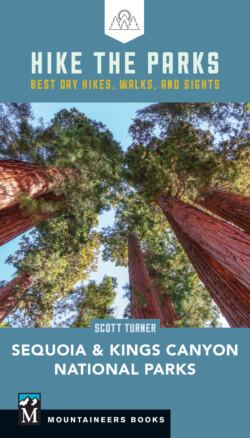Читать книгу Hike the Parks Sequoia-Kings Canyon National Parks - Scott Turner - Страница 17
FLORA
ОглавлениеSequoias. Despite inhabiting a relatively trivial amount of acreage throughout the parks and adjacent national forests and monuments, sequoias occupy a place of honor among the Sierra Nevada’s flora. With a size unparalleled anywhere, aside from the sequoia’s taller but thinner cousin, the coast redwood, the giant sequoia both impresses and bewilders visitors with its magnificence.
Sequoias grow rapidly and achieve impressive statures in a relatively short time. As observed at previously logged groves, such as Atwell Grove and Big Stump Grove, 120-year-old sequoias can tower over older white firs and sugar pines. The trees reach full height quickly, while the remainder of their growth occurs as the trees attain girth as they age (much like adult humans). Sequoias continue to grow until they become so large that their root systems can no longer support their weight. The number one cause of death among sequoias is toppling.
Sequoias can reach heights exceeding 270 feet (82 m), thicknesses of up to 40 feet (12 m) at the base, and weights exceeding thousands of tons. While other trees exceed the sequoia in terms of height (coast redwood and Douglas fir), age (bristlecone pines), and diameter (tule cypress), no other tree occupies as much sheer volume as a sequoia. Even the tree’s branches, many of which are the size of mature conifers, tell the tale of the tree’s massiveness. The lower branches of the Sherman Tree are larger than any single tree east of the Mississippi River.
Sequoias, unlike most other conifers, are uniquely well adapted to periodic wildfires. The tree’s fibrous, cinnamoncolored bark can be several feet thick and contains fire-resistant tannins—tannins that are resistant even to the hottest, most destructive fires and that also serve to repel termites and other wood-consuming insects, such as bark beetles. Sequoias also depend on fire for reproduction. Like most members of the cypress family, sequoia cones open and release their seeds in response to heat. During fires, sequoia cones open, showering the now bare forest floor with oatsized seeds. Following a fire, countless sequoia saplings will sprout from the ground. North Grove, which burned during the 2015 Rough Fire, displayed countless saplings a mere eight months following the massive conflagration.
Fire-resistant sequoias may have burn scars, but the flames rarely kill them.
